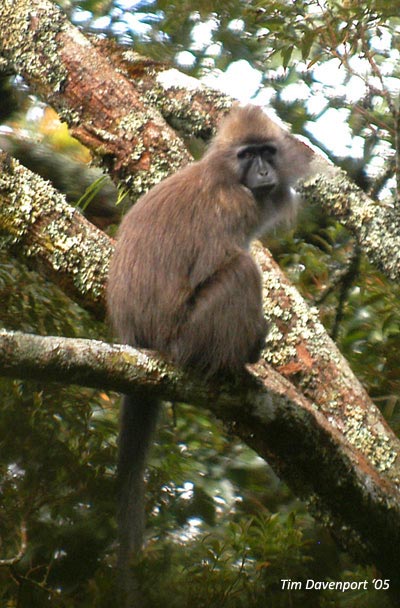Rare Monkey Interbred with Baboons, Study Suggests

One of Africa's rarest monkeys likely interbred with baboons in its past, new genetic research suggests.
The large monkey called Rungwecebus kipunji, or kipunji for short, was only discovered in 2003, and in 2006 it was found to be an entirely new primate genus, the first such addition since 1923. The shy tree-dwelling monkey, with a black face and long brown fur, resides in two forest patches in Tanzania totaling just 7 square miles (18 square km).
Scientists aren't sure when baboons, which include several species in the Papio genus, diverged from Rungwecebus. But the two look different, with baboons sporting a long flat nose not found in kipunji, and male baboons typically boasting a much larger body size, reaching up to about 65 pounds (30 kg). Male kipunji can weigh up to about 30 pounds (15 kg).
A team of researchers led by Trina Roberts of the National Evolutionary Synthesis Center in Durham, N.C., has just run genetic analyses of dung and tissue samples collected from both kipunji populations: one in Tanzania's Southern Highlands and the other nearby in the Udzungwa Mountains.
In samples from the Southern Highlands, they found bits of DNA similar to that of baboons, suggesting, the researchers say, the two primates interbred at some point after they diverged.
"Way back in time in the evolutionary history of this population there was at least one event where there was some cross-fertilization with a baboon," said study researcher Tim Davenport of the Wildlife Conservation Society.
The Udzungwa samples showed no traces of baboon DNA.
Sign up for the Live Science daily newsletter now
Get the world’s most fascinating discoveries delivered straight to your inbox.
Since the researchers examined mitochondrial DNA, which is passed down to offspring from the mother, they know the sexual relations must have occurred between a male kipunji and female baboon. But as for how the two primates met up for a romp, that's unclear. Kipunji primarily hide out in trees, while baboons are ground-dwelling.
"At the moment we are essentially telling stories about what happened at some point in evolutionary history," Roberts told LiveScience. "Baboons do enter forests to forage, escape predators and sleep, and kipunji do come down to the ground and have been observed outside forests."
The researchers are looking into whether the baboon DNA has given the kipunji any survival advantages and could possibly explain why roughly 1,000 of the monkeys live in the Southern Highlands (the population having baboon DNA) compared with just 100 in the Udzungwas.
"We have two separate populations that are slightly genetically different, so until we learn more it is extremely important that we maintain both of them," Davenport said. "It might be that those genetic differences have an impact on their survival in the future."
The research, detailed in the journal Biology Letters, was funded in part by the National Science Foundation and the Wildlife Conservation Society.
- Video – Clever Primates
- Monkey News, Information and Images
- Top 10 Species Success Stories
Jeanna Bryner is managing editor of Scientific American. Previously she was editor in chief of Live Science and, prior to that, an editor at Scholastic's Science World magazine. Bryner has an English degree from Salisbury University, a master's degree in biogeochemistry and environmental sciences from the University of Maryland and a graduate science journalism degree from New York University. She has worked as a biologist in Florida, where she monitored wetlands and did field surveys for endangered species, including the gorgeous Florida Scrub Jay. She also received an ocean sciences journalism fellowship from the Woods Hole Oceanographic Institution. She is a firm believer that science is for everyone and that just about everything can be viewed through the lens of science.










